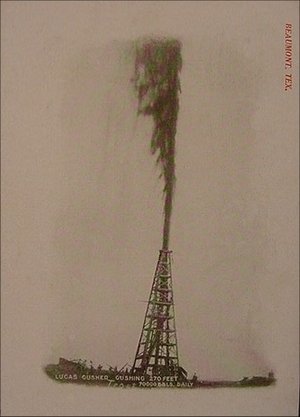|
Legendary
Texas swindlers, like Billie Sol Estes and Frank Sharp, knew well
that the human mind, when seduced by the possibility of making fabulous
sums of money in a short time, has an amazing ability to ignore good
judgement and common sense. For evidence look no further than Beaumont,
Texas in early days of the twentieth century.
When the Spindletop
oil field near Beaumont
came in on January 10, 1901, businessmen, investors, speculators,
charlatans, hustlers, and crooks from all over the world hurried to
Jefferson County;
each man convinced that destiny had selected him for riches. “There
is a wild excitement throughout Southeast Texas,” declared the New
York Times. The mad rush of humanity to a single place had not
been seen in such numbers since the discovery of gold in California
in 1849. The population of Beaumont
tripled in a few weeks. “Sidewalks weren’t wide enough to accommodate
the crowds which congest them day and night,” a reporter wrote. “So
great was the multitude that flocked to Beaumont
that it could not be housed or fed.” Everything was in short supply,
from whiskey to a few private moments in the toilet. Two days after
the field came in there was not a drop of liquor in Beaumont.
All 25 saloons had sold out. Boys made money by waiting in the long
lines at public outhouses, then selling their places to the highest
bidder as they got near the front.
Hundreds of potential buyers offered big money for a small amount
of real estate, sending land prices near Spindletop into the stratosphere.
One piece of property, originally purchased for less than $150, sold
for $20,000, then resold for $50,000, and resold again for $100,000.
J. N. Page of Georgetown
owned 15 acres four miles south of Beaumont.
He bought the land for $200. After the oil boom began he sold one
acre for $65,000 and the remaining 14 acres for $600,000 cash. The
purchaser was a syndicate that included ex-governor Jim
Hogg. James T. White owned 125,000 acres of land between Beaumont
and the Gulf of Mexico. He bought the land for a dollar an acre. After
the boom, Standard Oil offered him $2 million for the whole parcel,
but he held out for $3 million. After a few weeks of negotiations,
White sold 62,000 acres to Standard Oil for $1.25 million.
In crowded saloons and hotel lobbies, pieces of paper alleged to be
land titles changed hands with blinding speed; often backed only by
the seller’s word that the title was good. Lawyers worked day and
night handling legal challenges to land titles, many of which were
so faulty they would not hold up in court. The amount of land in Jefferson
County whose titles were in question was estimated to be as high
as 50 percent. Former landowners who once signed away their titles
and mineral rights for a few dollars an acre hired attorneys who miraculously
discovered flaws in the original documents. Heirs, some of whom had
never heard of Beaumont
and couldn’t find Texas on a map, came out of woodwork. The litigious
nature of the oil business began at Spindletop. |
 |
Lucas Gusher
gushing 170 feet
Postcard courtesy rootsweb.com/%7Etxpstcrd/ |
| At first the
massive amounts of oil that came out of the ground made inflated land
prices look like a steal. The Lucas Gusher at Spindletop
blew 70,000 barrels of oil a day into the air. At that pace, provided
it could be capped and provided oil prices held steady at forty cents
a barrel, that one well stood to make its owners $28,000 a day. Revenue
for a year would be over $10 million. And other gushers produced similar
results. The Palestine-Beaumont Well blew a stream of petroleum so
powerful that three men drowned in oil trying to cap it. Some oil
field workers used diving suits when working close to spewing wells.
Oil came out of the ground so fast and in such volume there was no
place to put it. Drillers damned up ravines to catch runaway petroleum,
creating lakes of oil that covered 50 to 75 acres and were 10 to 20
feet deep. |
Spindle Top Oil
Field, Beaumont,
Texas
Postcard courtesy rootsweb.com/%7Etxpstcrd/ |
0ver 200 oil
companies were formed in the first 90 days after Spindletop.
On April 10 alone, 15 new oil companies filed charters with the secretary
of state in Austin. But
even the handful of companies that struck oil discovered that getting
petroleum to the surface was the easy part. After that it had to be
stored, transported, refined, marketed, and sold. Small companies
did not have the capacity for such things. Only when the big companies,
like Standard Oil, Gulf, and The Texas Company (later Texaco) took
over did the business gain stability.
Unfortunately for investors, few of the oil companies formed after
Spindletop
survived for long. In the wild and unregulated atmosphere in Beaumont,
anyone with panache and a fast mouth could pass for an oil man. And
many of them had no intention of drilling for oil. Their only mission
was to sell fraudulent land titles and “watered” oil company stock
to unsuspecting investors who got caught up in the drama and excitement
of Spindletop
and traded their life savings for “wind and hot air.” Then the so-called
oil men, their mission accomplished, vanished with the cash like a
puff of smoke on a windy day.
The New York Times estimated that $75 million in oil stocks were sold
in the first 90 days after Spindletop
came in. Much of it proved to be worthless. Most small investors never
stood a chance.
© Michael Barr
"Hindsights" August
19 , 2015 Column
Sources:
Judith Walker Linsley, Ellen Walker Rienstra, and Jo Ann Stiles,
Giant Under the Hill: A History of the Spindletop Oil Discovery (Austin:
Texas State Historical Association, 2002)
New York Times, January 13, 1901, March 26, 1901, May 8, 1901, August
29, 1901 |
|
|
